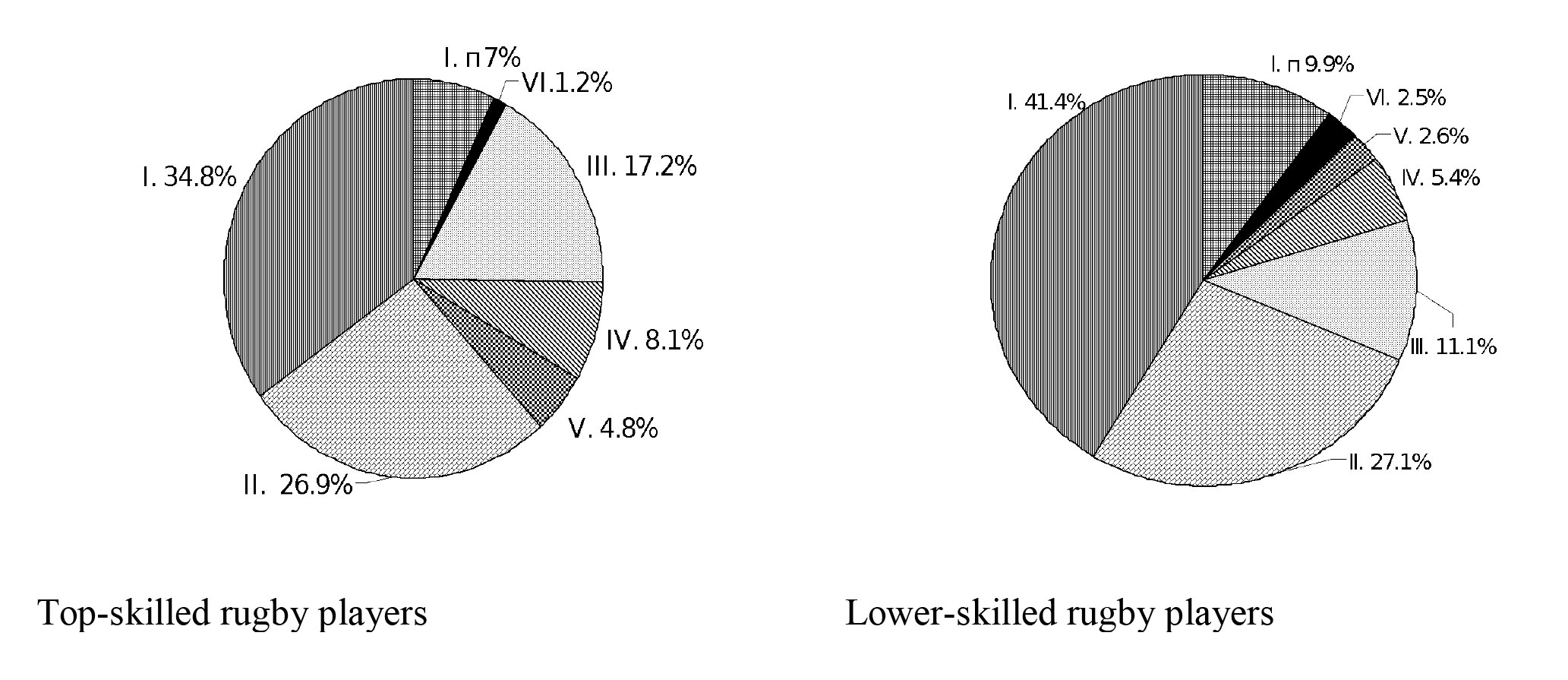Skills-specific competitive timeframes in rugby sport
Фотографии:
ˑ:
PhD, Associate Professor O.P. Kokoulina1
PhD, Associate Professor S.Yu. Tatarova1
V.V. Averyasov1
Yu.V. Kruglova1
1Plekhanov Russian University of Economics, Moscow
Keywords: game process, game modeling, timing, total time of game, net time of game, single-, double- and triple-element game moments.
Background. Every training process design and management initiative in modern sports needs to be supported by due theoretical grounds for competitive progress. One of the necessary preconditions for improvement of any training system is that the training system design will factor in the objective competitive performance data including the process timing parameters.
Objective of the study was to analyze the competitive performance timing data in modern elite rugby.
Methods and structure of the study. The study was designed to apply an isomorphic competitive performance rating unit with the relevant process timing parameters to profile and analyze the competitive performance in modern elite rugby.
Study findings and discussion. Game process in the modern rugby sport may be described as a sequence of high-intensity time intervals (collectively referred to as net game time or game intervals when teams compete for the ball) alternating with passive game servicing intervals when the teams are rearranged (referred herein as servicing intervals) for the further game. This game-specific time requirements of the sport cannot but determine the physical and mental qualities critical for competitive success.
Total time of the game may vary despite the fact that the game rules restrict it by two 40-minute times, since the referee must extend the game time till the ball is dead; plus the referee must add the time lost in many game delays including the time claimed by preparations for shots on goal, medical service to injured players etc. These game delays standardized by the valid Rules of the Game result in the standard match time being extended; and this is one of the game specifics that require the athletes’ physical fitness being specific as well. On average every time takes around 42min in total, with the total time of the game averaging 83-84min and coming to 90min in some cases.
Net time of the game may vary depending on the skill levels of the rugby teams as verified by our match timing study of 32 matches of the 2015 World Cup finals and 2015-16 Rugby Championship; and 20 matches of the 2015-16 Russian Championship in the Super/ Major Leagues. The match timing study showed that the higher is the skill level of the players the higher are the net times of the matches: see Table 1 hereunder.
Table 1. Net times of the matches versus the players’ skill levels
|
Events |
Net time of the game, Х±m |
||
|
Match |
First time |
Second time |
|
|
2015 World Cup finals; 2015-16 Rugby Championship |
35min 38s±67s |
18min 29s±31s |
17min 09s±36s |
|
2015-16 Russian Championship |
30min 00s±42s |
15min 33s±20s |
14min 27s±22s |
The above correlation may be explained by the better and higher tactical thinking, technical mastery, physical qualities, motor skills and performance rates of the highly-skilled athletes making their game process more time-efficient. This means that it takes less time for them to make the technical and tactical decisions to attain specific game goals in every game element due to their higher technical and tactical mastery and better physical fitness. The total and net times of the game may provide a good guidance for the training process planning and management efforts, particularly at the pre-season stage – as the game process timing data give the means to model the competitive performance in the training process to secure the training and competitive conditions being as close as possible.
The study found that the net match time structure is also skill-specific as demonstrated by Figure 1 hereunder.

Figure 1. Net time structure versus the players’ skill levels:
Iп – single-element simple game moments; I – single-element complex game moments; II – double-element game moments; III – triple-element game moments; IV – four-element game moments; V – five-element game moments; VI – six-element game moments
On average the game elements were timed as follows: single-, double- and triple-element complex game moments averaged 745s, 576s and 368s, respectively. The net time structure of the top- versus lower-skilled players is not much different in the single-to-triple-element sectors on the above diagrams. This means that the single-to-triple-element game moments were found to account for most of the net time of the game, with the single-, double- and triple-element game moments accounting for 41.4%, 27.1% and 11.1% of the net game time, respectively, in case of the lower-skilled players. In the absolute time terms, the single-, double- and triple-element game moments were found to account for 726s, 488s and 201s, respectively.
Thus the net time of the game may be described as the integrated parameter to rate the competitive performance and, hence, the requirements to the physical/ mental fitness indices of the players. A special priority in the net time structure analysis will be given to the elementary time structure of the game moments as it provides a good guidance for the precompetitive training process design and management.
The competitive performance timing versus the skill levels showed the following. In case of the top-skilled rugby players, the 3-8s game moments were found to make up 35% of the total game moments; with the single-to-triple-element game moments measured to take 8-15s (16%), 15-25s (15%) and 25-35s (17%), 35-45s (5%), 45-60s (6%), 60-80s (4%) and above 80s (2%). In case of the lower-skilled players, the elementary time structure of the game moments is the following: 3-8s (40%), 8-15s (24%), 15-25s (23%), 25-35s (10%), 35-45s (6 %), 45-60s (3%), 60-80+s (up to 1%).
On the whole, the process timing data analysis shows that the net time may be classified into the following three time zones. The largest Time zone 1 (under 35s) accounts for 89% and 83% in the top- and lower-skilled matches being dominated by the single-, double- and triple-element game moments. Time zone 2 (35-80s) is skills-specific, being 35-80s (15% of the net game time) wide for the top-skilled and 35-60s (9% of the net game time) wide for the lower-skilled players. And Time zone 3 is 80+s wide (2% of the net game time) and 60+s wide (1% of the net game time) for the top- and lower-skilled players, respectively. Therefore, the elementary time structure of the game moments is skills-specific, with the numbers of game moments in Time zones 2 and 3 higher and accounting for 17% and 10% of the net game time for the top- and lower-skilled players, respectively.
Game servicing intervals may be classified by their timing into the following three types. Fast GSI type (taking less than 3s) requires virtually no rearrangement for the teams to restart the game, and accounts for 5% and 2% of the total GS time in the top- and lower-skilled matches, respectively. Average GSI type (taking 3-40s) accounts for 71% and 81% of the total GS time in the top- and lower-skilled matches, respectively. And the long GSI type (taking 40+s) accounts for 24% and 17% of the total GS time in the top- and lower-skilled matches, respectively. On the whole, a game rhythm is determined by the sequence of the 3-163s long game moments and 3-98s long game servicing intervals.
Conclusion. The study data show the need for the athletes’ mastery and competitive progress to be secured by an integrated training process designed as required for the competitive success.
References
- Andryushchenko L.B., Filimonova S.I. Fizicheskaya kultura i studencheskiy sport v novyih sotsialno-ekonomicheskih usloviyakh Rossii: sovremenny vzglyad i tochki rosta [Physical education and academic sports in new socio-economic national situation: modern vision and growth points]. Teoriya i praktika fiz. kultury, 2018, no. 2, pp. 73-76.
- Ivanov V.A. Integralnaya podgotovka v strukture trenirovochnogo protsessa kvalifitsirovannykh regbistov. Dis. kand. ped. nauk [Integrated training in training process design of skilled rugby players. PhD diss. abstract]. Moscow, 2004, 188 p.
- Ivanov V.A. Soderzhanie tekhniko-takticheskikh priemov v sorevnovatelnoy deyatelnosti regbistov [Technical and tactical methods in competitive activity of rugby players]. Teoriya i praktika fiz. kultury, 2006, no. 4, pp. 32-34.
- Kokoulina O.P. Osnovy teorii i metodiki fizicheskoy kultury i sporta [Fundamentals of theory and methods of physical culture and sports]. Study guide. Moscow: PRUE publ., 2016, 113 p.
- Nesterovskiy D.I., Zheleznyak Y.D., Ivanov V.A. et al Teoriya i metodika sportivnykh igr. Uchebnik dlya stud. uchrezhdeniy vysshego obrazovaniya [Theory and methods of sport games. Textbook for higher schools]. Moscow, 2014. (9th ed. ster.)
Corresponding author: kokoulinaop@mail.ru
Abstract
The study analyzes the skill-specific competitive performance timing data in modern rugby, with the external parameters of the game process including the total and net game times in competitions of different levels. The study also considers the internal time structure of the game process versus the technical and tactical intensity of the game moments and players’ skill levels in the competitive matches. The skills-specific study data for a comparative analysis were obtained from the match records. The study data and analyses give the means to conclude that higher skills, formal qualifications and actual mastery levels result in wider variations of competitive performance time elements including total game time, elementary game moments and game service intervals. In this context the competitive performance is recommended to be designed with the above elements being duly taken into account and harmonized. The study data show the need for the athletes’ mastery and competitive progress being secured by an integrated training process designed as required for the competitive success.



